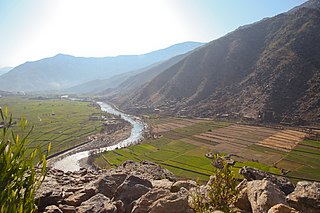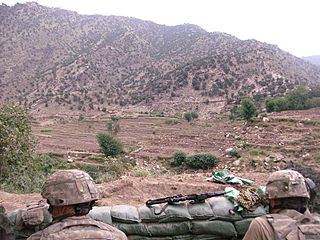
Kunar is one of the 34 provinces of Afghanistan, located in the northeastern part of the country. Its capital is Asadabad. Its population is estimated to be 508,224. Kunar's major political groups include Wahhabis or Ahl-e- Hadith, Nazhat-e Hambastagi Milli, Hezb-e Afghanistan Naween, Hezb-e Islami Gulbuddin.

Operation Mountain Fury was a NATO-led operation begun on September 16, 2006 as a follow-up operation to Operation Medusa, to clear Taliban insurgents from the eastern provinces of Afghanistan. Another focus of the operation was to enable reconstruction projects such as schools, health-care facilities, and courthouses to take place in the targeted provinces.

Operation Herrick was the codename under which all British operations in the War in Afghanistan were conducted from 2002 to the end of combat operations in 2014. It consisted of the British contribution to the NATO-led International Security Assistance Force (ISAF), and support to the American-led Operation Enduring Freedom (OEF), within the South Asian country.

In January 2006, NATO's focus in southern Afghanistan was to form Provincial Reconstruction Teams with the British leading in Helmand Province and the Netherlands, Australia and Canada leading similar deployments in Orūzgān Province and Kandahar Province respectively. The United States, with 2,200 troops, stayed in control of Zabul Province. Local Taliban figures voiced opposition to the incoming force and pledged to resist it.

The following items form a partial timeline of the War in Afghanistan. For events prior to October 7, 2001, see 2001 in Afghanistan.

The siege of Sangin was a military engagement which occurred between June 2006 and April 2007, between Taliban insurgents and the British Army during the war in Afghanistan. During the engagement, the district centre of Sangin District in Helmand Province was occupied by British forces and was completely surrounded by Taliban fighters. At one point fighting became intensive, causing General David J. Richards, the then-NATO commander in Afghanistan, to declare that Helmand province had seen the fiercest fighting involving British troops since the Korean War. The siege became emblematic of the difficulty of the mission being carried out by British soldiers in Afghanistan, who nicknamed it "Sangingrad".

The Helmand province campaign was a series of military operations conducted by the International Security Assistance Force (ISAF) forces against Taliban insurgents and other local groups in the Helmand Province of Afghanistan. Their objective was to control a province that was known to be a Taliban stronghold, and a center of opium production. None of the ISAF's intended strategic and political objectives were achieved in the long term.

US and NATO International Security Assistance Force (ISAF) operations, alongside Afghan National Army forces, continued against the Taliban through 2007.

The Battle of Wanat took place on July 13, 2008, when around 200 Taliban insurgents attacked American troops stationed near Quam, in the Waygal district of Afghanistan's far eastern Nuristan province. The distant position was primarily defended by United States Army soldiers with 2nd Platoon, Chosen Company, 2nd Battalion, 503rd Infantry Regiment (Airborne), 173rd Airborne Brigade Combat Team.

French International Security Assistance Force (ISAF) troops were ambushed by Afghan Taliban insurgents, with heavy casualties, in the Uzbin Valley outside the village of Spēṟ Kunday in the Surobi District of Kabul province in eastern Afghanistan on 18 August 2008.

The siege of Musa Qala took place between July 17 and September 12, 2006 in Afghanistan's Helmand province. A small force of International Security Assistance Force (ISAF) troops and Afghan security forces were besieged by Taliban insurgents inside the district centre of Musa Qala.
There were 2,402 United States military deaths in the War in Afghanistan, which lasted from October 2001 to August 2021. 1,921 of these deaths were the result of hostile action. 20,713 American servicemembers were also wounded in action during the war. In addition, 18 Central Intelligence Agency (CIA) operatives also died in Afghanistan. Further, there were 1,822 civilian contractor fatalities.
The Battle of Dahaneh took place in the town of Dahaneh, Helmand Province, and its surrounding areas as part of the Afghanistan War. It began when U.S. and Afghan troops launched an Operation to capture the town from the Taliban, in the Helmand Province of Southern Afghanistan. Coalition troops met heavy resistance, and believe the Taliban were forewarned of the incoming attack, though they were successful in securing Dahaneh.

The Battle of Kamdesh took place during the war in Afghanistan. It occurred on October 3, 2009, when a force of 300 Taliban assaulted the American Combat Outpost ("COP") Keating near the town of Kamdesh in Nuristan Province in eastern Afghanistan. The attack was the bloodiest battle for US forces since the Battle of Wanat in July 2008, which occurred 20 miles (32 km) away from Kamdesh. The attack on COP Keating resulted in 8 Americans killed and 27 wounded while the Taliban suffered 150-200 killed.
The following lists events that happened during 2006 in Afghanistan.
Events from the year 2009 in Afghanistan
Operation Moshtarak, also known as the Battle of Marjah, was an International Security Assistance Force (ISAF) pacification offensive in the town of Marjah, Helmand Province, Afghanistan. It involved a combined total of 15,000 Afghan, American, British, Canadian, Danish, and Estonian troops, constituting the largest joint operation of the War in Afghanistan up to that point. The purpose of the operation was to remove the Taliban from Marja, thus eliminating the last Taliban stronghold in central Helmand Province. The main target of the offensive was the town of Marjah, which had been controlled for years by the Taliban as well as drug traffickers.

On 6 August 2011, a U.S. CH-47D Chinook military helicopter operating with the call sign Extortion 17 was shot down while transporting a Quick Reaction Force attempting to reinforce a Joint Special Operations Command unit of the 75th Ranger Regiment in the Tangi Valley in Maidan Wardak province, southwest of Kabul, Afghanistan.

The Aranas ambush was an attack by the Taliban against a US-Afghan patrol returning from a tribal meeting. The Taliban inflicted heavy casualties on US-Afghan forces, and the Americans managed to evacuate with their wounded in the darkness.













